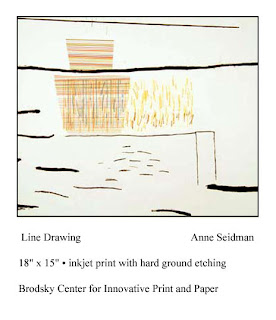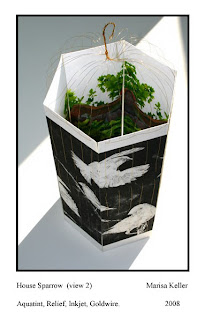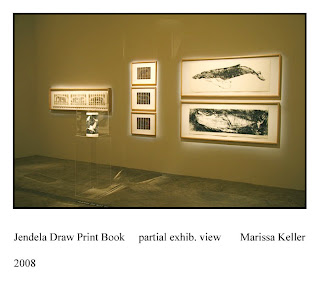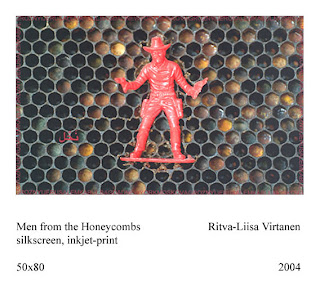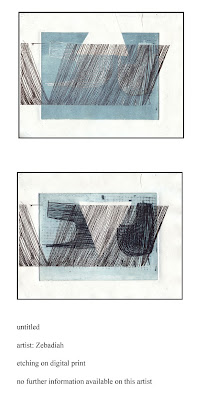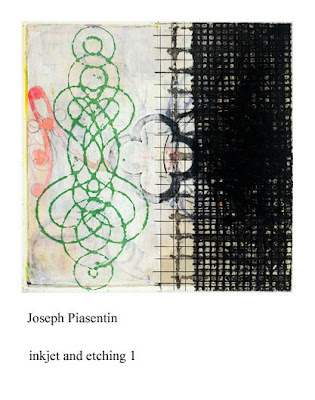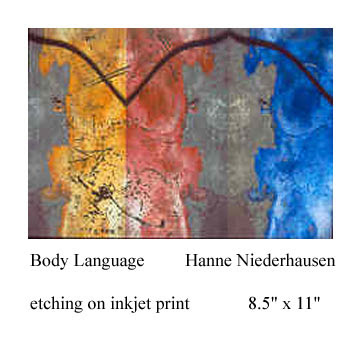Aine: Firstly, Dennis I’d like to thank you for agreeing to have this interview, and giving of your time.
Dennis: No Problem, anything to share what I do.
Aine: These are questions thoughts that have occurred to me as I have looking through your artwork. As you are aware, Dennis, Iammainly, viewing the ‘tradigital” prints, as this is the particular focus on my blog.
Dennis: Excellent I find that there are few forums to discuss “tradigital” printmaking, typically it's explicitly one or the other: hardcore traditional or hardcore technology/new media, never a blend.
Aine: What I was wondering was……………… how long have you been a practicing printmaker?
Dennis: I've been a practicing printmaker and artist for the last 10 years, including my time as an undergraduate student and graduate student.
Aine: Were you working as a more “general” fine artist prior to that………..or what? Did you or in fact do you paint at all or have you used any other medium?
Dennis: Actually during my time at art school, in the very beginning I had originally intended to be a painter and didn't really know what printmaking even was. I ended up studying printmaking early on as a fluke by needing to take a certain number of class requirements. At the time I didn't know that it'd stick with me long after the initial class.
Aine: In your work as a printmaker – what were the processes you worked with initially?
Was this influenced by the facilities that were available to you? Did you have access to a print workshop?
Dennis: Initially as with most people- I worked in relief in linoleum and wood blocks “here and there” but never seriously studied it. It wasn't until college when I was introduced to intaglio that I understood it as a mature art medium.
Yes facilities played a large roll with my introduction to printmaking. My undergraduate schooling had a fabulous world-class print facility. Yes. As a student I had access most of the day if there wasn't a class in session. And through the years I've had access at a variety of co-ops or print facilities at schools I've taught at.
Aine: Were there certain processes that you felt suited your ‘style’ as such, or was it a case of you wanting to try out everything e.g. screen-printing, intaglio, woodcut litho etc.??
 Dennis:
Dennis: Largely Intaglio. It was my first “true” introduction to the printmaking discipline and it stuck with me more than the other mediums I tried. However based upon the initial idea- or facilities available- the medium does tend to change. However intaglio and mezzotint are always going to be in a soft spot for me, and if I have facilities available at the time I try to get my time into them.
Aine: I see that you studied for a bachelors and a Masters degree ……………was that important for you -- I mean to undertake a master’s degree?
Dennis: For the bachelor's degree it was necessary. Art is one of those fields that one doesn't need a degree in to be a professional- but it helps a great deal. In theory I could have learned everything I did on my own- it just would have taken eight times longer and I probably wouldn't have studied printmaking. So for my undergraduate experience I'm quite grateful for it.
I went directly into a master's program after my bachelor's, and finished in 2 years. It was important for me to do a master's sooner than later. My reasons for doing so were two fold I wanted to continue my own “research” and gain the necessary credentials to teach.
Aine: Was your course a good one? Did the educational institution you attended - have a “house style” as such, OR were individual expressions/ identities encouraged. Do you feel that you were ‘tutored’ in its refinement / sophistication?? i.e., to take it to perhaps a higher level??
Dennis: I suppose yes, as the events lead me to where I am now. My undergraduate experience was very structured in a highly traditional printmaking environment, however there was no “house style” in the studio- we were encouraged to explore where ever the medium took up personally- self expression was pushed greatly at Cornish College in Seattle- where I attended.
Technical medium and process were kept slightly separate from content. So there was a large push for refinement of skill. My graduate experience at the University of California at Davis was more for independent work, that's where the digital aspects of my work started to become apparent, and where I first became an instructor of art.
Both my undergraduate and graduate schools were mixed interdisciplinary programs, which allowed for quite a bit of freedom expression.
 Aine:
Aine: What did you hope to get out of immersing yourself inside that process (of doing the M.A.)?
Dennis: Mainly for teaching credentials, and more solo work time to explore with minimal amounts of faculty peering and “baby sitting.” Graduate school was also more like a 2 year residency, so I didn't have to worry about “paying bills” much as I would have had to do “in real life” after finishing my bachelor's program.
Aine: Did these hopes become realized to a greater or lesser extent?
Dennis: To a greater extent they were. I went down a fairly different path with my work from where I started at the end of my bachelors program, I had finished there by making a series of 10 mezzotints (“one of my favorite things” etc), to making digital prints in graduate school. My master's program was fairly grueling, often feeling like I was in a war zone. Mainly from the everyday politics of the department. Much of the departmental politics were shielded as an undergraduate – but I in a master's program I could see the inner workings which can be a highly frustrating experience.
 Aine:
Aine: Now I ‘d like to ask you about how you arrived at a situation where you started incorporating digital along with traditional printmaking techniques??
Dennis: I had always played around with the idea of incorporating digital medium with traditional printmaking when I was an undergraduate- but the technology wasn't “quite there” in the 1990's when I was a student. The technology finally caught up when I was a grad student in 2001-2003. A lot of the digital output I was using couldn't take the abuse of being wet or being ran through a press until really only a handful of years ago.
Aine: Do you remember the first one you did? Is it viewable online or is it “secreted away” somewhere?
Dennis: Hah, I think with enough time- all of my work gets “secreted away.” I think my first direct tradigital print was the intaglio, chine colle print “Homeland Security”. It was in my masters thesis show, it's 32 X 24 inches and I tried to “go out with a bang” and make the biggest print possible for my first venture into tradigital printmaking.
Aine: Can you say what do you like about working in this way - i.e, tradigitally?
Dennis: For the most part I was trained and used a computer since I was really a child and learned academic art and drawing when I was an adult in college, so there was a certain amount of familiarity there for me, that I'm not sure I would have had if the situation were the other way around.
But I noticed that I was trying to blend the two mediums together - not have a traditional print with blatant digital components smacked on top.
I wanted to integrate the two and use it (the digital) as “just another tool” for my own ends. Also - now that it's been a few years since I had the free-time of a student, I've found that utilizing a digital component also can save some time - albeit only a little as it is still time consuming.
Aine: oh what is your physical set up..........do you work from a studio in your home or do you only use an open access print workshop?
 Dennis:
Dennis: I currently work out of a home studio with my digital set-up and silkscreen set up. I usually work with intaglio if I'm teaching a college course and utilize the press - or work with a local co-op where ever I happen to be living. I had been living in California in San Francisco up until a year and a half ago, moving to Seattle for a teaching position.
Aine: For digital print – what kind/size printer do you have e.g. A4 or A3+, or larger ?
Dennis: I have an “old” work horse, and Epson 2200, which prints Super B (13”X19”) and has a width of 13” and a length of 44” I believe dependent upon paper size. It prints on a wide variety of surfaces, and paper types.
Aine: Is it a pigment printer or a dye based one?
Dennis: It's a “pigmented-dye” ink, whatever that means. It's rated to have a “100 year life” on printmaking paper, and the ink is waterproof- allowing for the “press abuse.”
Aine: Do you use ordinary typical printmaking paper e.g. Fabriano arches rives BFK, Hahnemuhle etc
OR do you use the printers specialists ‘proprietary’ brands e.g. Epson papers and so forth.
Dennis: For the most part I use almost exclusively printmaking paper - with much success on western and eastern papers.
Aine: Perhaps you use all sorts of paper?
Dennis: I have recently used coated papers made for digital printers in conjunction with silkscreen. I found that the special coating works well with silkscreen.
Aine: Do you give consideration to the question of "archivibility"/ permanency? What are your thoughts on this aspect?
Dennis: I'm less concerned about “archivalness”- as more then likely, the work will out live me by quite a few years.
Aine: Do you get the overall idea for the “finished print” first and then plan out how you will realize it?
Dennis: A little of both. I plan things out meticulously, and then execute. However even in a digital setting, I still have to make adjustments and changes. Some times the changes are little, other times there's no resemblance at all in the finished product.
Aine: Perhaps you print out “backgrounds – I do this myself) and then try them out by printing on top of them with a woodblock or other “print plate”?
Dennis: I had originally started using the digital components as a background- but have branched out and have digital components in different aspects of the work. There are some parts which are about 90% digital and others that have none in the final product- but I use Photoshop as a drawing/drafting tool.
Aine: I note from your CV that you teach and wondered if your students show an interest in integrating the old and the new printing technologies. ??
Dennis: Some do, some don't. If they have an interest and the facilities, then it opens up another avenue for creation.
Aine: Dennis -- it would be interesting if you would talk somewhat about the ideas with some of your prints?
There's a recent one, called, “I’ll hide away for another day”.

How did you go about making that piece. I was wondering whether the trees that are layered behind the transparent red, have any bearing on the title/meaning ? Is that little container jar supposed to, in a way, be like a little desert island ‘away from it all’, an oasis perhaps? Those are just my thought.... when looking at the piece ?
Dennis: “I'll Hide away for Another Day”
has two meanings. One that I get from most observers, is an environmental one, saving nature and the ecosystem while it's still around, hence the red used as a warning colour. The other meaning, is that which you have interpreted. It's about hiding away from everything, just to get away, everyone has a pocket oasis somewhere.
Aine: In “There doesn’t seem to be anyone who agrees with me”, did you print the couple in the background first and then perhaps print the cigarette pack on top using something like a hard ground etch? Is that piece to do with being a smoker in a non-tolerant world or perhaps it’s to do with religions and intolerance? that said - as I notice the ‘icons’ on the cigarette pack? Is that printed on “albaca” paper or something similar ?
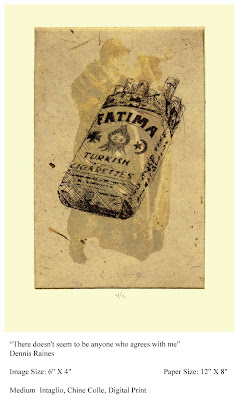 Dennis:
Dennis: With “There doesn't seem to be anyone who agrees with me” I was going over the history of smoking in the world, and the nostalgia of smoking and the totally different view of smoking in the past and touching upon the world universality of smoking (for better and worse).
Technically speaking there's chine colle sheet with the couple digitally printed on it, and the pack of cigarettes is just a simple line etching and aquatint.
It's a little more obvious with the digital component compared to other's I've done like “thinking back to god knows when”
which is less obvious (to me anyway), and the other prints I'm currently working on. The paper is a sheet of Hanemuhle copper plate, and the chine colle is a heavy weight Mitsumata.
Aine: The other piece I would appreciate you talking about is “Homeland Security”?
Dennis: “Homeland security” is a piece that was part of my master's thesis show from 2003. I attended graduate school directly after undergraduate school and moved from Seattle to California, and was quite excited to start my new life in my new home, and had moved to California on the night of September 10th 2001, making my first official day of my new life the 11th. Which wasn't the best was to start. The print came about from the politically turbulent years that followed, which made me quite the jaded student, with what was going on socially and politically in America at that time. People were scarred to death of everything to the point of stupidity, and giving unchecked power to the very people who were in charge at the time.

So from a technical stand point I wanted to make a statement and make the largest intaglio print possible. I combined for the first time direct digital components, I used 3 plates all at a size of 24” X 32” with a large chine colle piece (the yellow) and 20 smaller singular pieces of chine colle (the “pages”). I used the large press available to me, which was a custom built Hunter Penrose Little John press, that had a press bed that measured about 48” X 36” or so- and printed wonderfully. Before I stated my graduate studies, the press was used as a table. I like to think that I made an impression while I was there, but realistically it's probably a table again today. Strangely because of the graduate school department, there was a huge push for digital everything, to replace anything and everything traditional- including printmaking which was seen as “quaint.” That mind set is what contributed me to work in the fashion that I do now- using digital seamlessly as another tool in printmaking. I made a giant staggering edition of 1/1 with that print, due to the complexity. I wanted to make both digital and traditional media exist in harmony with each other. I started using the term “print media” instead of printmaking.
Aine: Is it printed on pages from a book or something along those lines or perhaps it was your intention that the digital print ‘ground’ as it were, should give that ‘semblance’, that ilk ?
Dennis: The images used were taken from the department of Homeland security which was created post 09/11/01 in the United States. They had made a pamphlet with “what to do in emergencies” which are all fairly ridiculous and did nothing but monger fear. I chose to have them be in a grid like fashion in each on it's own, trying to represent some sort of order, but chaos ruled it- representing the text over everything.
Aine: I notice that you don’t seem to have tried woodblock with digital print - do you think you might?
Dennis: No I haven't, it's one of those things that I just haven't tried yet. Mainly because the more linear intaglio and the method of silkscreen have given me more interest through the years than relief has, but I do have some ideas at some point for relief. It's just a matter of getting there.
Aine: Finally what artwork are you focusing on at present – what are you making. Is it for a particular exhibition/ portfolio or a series with which you are long term engaged?
Dennis: There's no end goal currently with the bodies of work I'm doing presently. Although showing is always bouncing around my mind - as is a tenure track position at a college (I'm only part time adjunct at the moment), but as of now I'm just having a blast making what I'm making.
There's a variety of work currently, a “large” series of digital + silkscreen prints.
I'm also doing a series of “art products” like my “Jackson Pollock Pale Ale” beer, strangely I consider these to be print media, as they are editioned and mechanical reproductions.

And also, I've started to paint again, which I hadn't' done in quite some time and they're far from being "showable" at this point. All in all even working in a variety of mediums and embracing digital tools - at heart I still and always consider myself a printmaker/print media artist.
Thanks for giving me this opportunity to share.






